Shoe Cushioning Effects on Foot Loading and Comfort Perception during Typical Basketball Maneuvers
Abstract
:1. Introduction
2. Materials and Methods
2.1. Participants
2.2. Shoes and Instrumentations
2.3. Experimental Protocol
2.4. Data Processing and Analysis
2.5. Statistics
3. Results
3.1. Vertical GRF
3.2. Maximum Plantar Pressure
3.3. Foot Pressure Distribution
3.4. Comfort Perception
4. Discussion
4.1. Vertical GRF
4.2. Plantar Pressure Characteristics
4.3. Comfort Perception
4.4. Limitations
5. Conclusions
Author Contributions
Funding
Conflicts of Interest
References
- Randers, M.B.; Hagman, M.; Brix, J.; Christensen, J.F.; Pedersen, M.T.; Nielsen, J.J.; Krustrup, P. Effects of 3 months of full-court and half-court street basketball training on health profile in untrained men. J. Sport Health Sci. 2018, 7, 132–138. [Google Scholar] [CrossRef] [PubMed]
- Nin, D.Z.; Lam, W.K.; Kong, P.W. Effect of body mass and midsole hardness on kinetic and perceptual variables during basketball landing manoeuvres. J. Sport. Health Sci. 2016, 34, 756–765. [Google Scholar] [CrossRef] [PubMed]
- Meeuwisse, W.H.; Sellmer, R.; Hagel, B.E. Rates and risks of injury during intercollegiate basketball. Am. J. Sports Med. 2003, 31, 379–385. [Google Scholar] [CrossRef] [PubMed]
- Irmischer, B.S.; Harris, C.; Pfeiffer, R.P.; DeBeliso, M.A.; Adams, K.J.; Shea, K.G. Effects of a knee ligament injury prevention exercise program on impact forces in women. J. Strength Cond. Res. 2004, 18, 703–707. [Google Scholar] [PubMed]
- Chiu, H.T.; Shiang, T.Y. Effects of insoles and additional shock absorption foam on the cushioning properties of sport shoes. J. Appl. Biomech. 2007, 23, 119–127. [Google Scholar] [CrossRef] [PubMed]
- Morlock, M.; Nigg, B.M. Theoretical considerations and practical results on the influence of the representation of the foot for the estimation of internal forces with models. Clin. Biomech. 1991, 6, 3–13. [Google Scholar] [CrossRef]
- Blackmore, T.; Ball, N.; Scurr, J. The effect of socks on vertical and anteroposterior ground reaction forces in walking and running. Foot 2011, 21, 1–5. [Google Scholar] [CrossRef]
- Nilsson, J.; Thorstensson, A. Ground reaction forces at different speeds of human walking and running. Acta Physiol. 2010, 136, 217–227. [Google Scholar] [CrossRef]
- Lam, W.K.; Qu, Y.; Yang, F.; Cheung, R.T.H. Do rotational shear-cushioning shoes influence horizontal ground reaction forces and perceived comfort during basketball cutting maneuvers? PeerJ 2017, 5, 1–13. [Google Scholar] [CrossRef]
- Wei, Q.; Wang, Z.; Woo, J.; Liebenberg, J.; Park, S.K.; Ryu, J.; Lam, W.K. Kinetics and perception of basketball landing in various heights and footwear cushioning. PLoS ONE 2018, 13, e0201758. [Google Scholar] [CrossRef]
- Lam, W.K.; Ng, W.X.; Kong, P.W. Influence of shoe midsole hardness on plantar pressure distribution in four basketball-related movements. Res. Sports Med. 2017, 25, 37–47. [Google Scholar] [CrossRef] [PubMed]
- Nigg, B.M.; Bahlsen, H.A.; Luethi, S.M.; Stokes, S. The influence of running velocity and midsole hardness on external impact forces in heel-toe running. J. Biomech. 1987, 20, 951–959. [Google Scholar] [CrossRef]
- Brizuela, G.; Llana, S.; Ferrandis, R.; Garcia-Belenguer, A.C. The influence of basketball shoes with increased ankle support on shock attenuation and performance in running and jumping. J. Sports Sci. 1997, 15, 505–515. [Google Scholar] [CrossRef] [PubMed]
- Jordan, C.; Payton, C.; Bartlett, R. Perceived comfort and pressure distribution in casual footwear. Clin. Biomech. 1997, 12, 215–220. [Google Scholar] [CrossRef]
- Robbins, S.; Waked, E.; Krouglicof, N. Improving balance. J. Am. Geriatr. Soc. 1998, 46, 1363–1370. [Google Scholar] [CrossRef] [PubMed]
- Hennig, E.M.; Valiant, G.A.; Qi, L. Biomechanical Variables and the Perception of Cushioning for Running in Various Types of Footwear. J. Appl. Biomech. 1996, 12, 143–150. [Google Scholar] [CrossRef]
- Dinato, R.C.; Ribeiro, A.P.; Butugan, M.K.; Pereira, I.L.R.; Onodera, A.N.; Sacco, I.C.N. Biomechanical variables and perception of comfort in running shoes with different cushioning technologies. J. Sci. Med. Sport 2015, 18, 93–97. [Google Scholar] [CrossRef] [PubMed]
- Lam, W.K.; Sterzing, T.; Cheung, J.T.M. Reliability of a basketball specific testing protocol for footwear fit and comfort perception. Footwear Sci. 2011, 3, 151–158. [Google Scholar] [CrossRef]
- Roca-Dols, A.; Elena Losa-Iglesias, M.; Sanchez-Gomez, R.; Becerro-de-Bengoa-Vallejo, R.; Lopez-Lopez, D.; Palomo-Lopez, P.; Rodriguez-Sanz, D.; Calvo-Lobo, C. Electromyography activity of triceps surae and tibialis anterior muscles related to various sports shoes. J. Mech. Behav. Biomed. Mater. 2018, 86, 158–171. [Google Scholar] [CrossRef]
- Roca-Dols, A.; Losa-Iglesias, M.E.; Sanchez-Gomez, R.; Becerro-de-Bengoa-Vallejo, R.; Lopez-Lopez, D.; Rodriguez-Sanz, D.; Martinez-Jimenez, E.M.; Calvo-Lobo, C. Effect of the cushioning running shoes in ground contact time of phases of gait. J. Mech. Behav. Biomed. Mater. 2018, 88, 196–200. [Google Scholar] [CrossRef]
- Price, C.; Parker, D.; Nester, C. Validity and repeatability of three in-shoe pressure measurement systems. Gait Posture 2016, 46, 69–74. [Google Scholar] [CrossRef] [PubMed] [Green Version]
- Nigg, B.M.; Anton, M. Energy aspects for elastic and viscous shoe soles and playing surfaces. Med. Sci. Sports Exerc. 1995, 27, 92–97. [Google Scholar] [CrossRef] [PubMed]
- Patrek, M.F.; Kernozek, T.W.; Willson, J.D.; Wright, G.A.; Doberstein, S.T. Hip-abductor fatigue and single-leg landing mechanics in women athletes. J. Athl. Train. 2011, 46, 31–42. [Google Scholar] [CrossRef] [PubMed]
- Thompson, M.A.; Lee, S.S.; Seegmiller, J.; Mcgowan, C.P. Kinematic and kinetic comparison of barefoot and shod running in mid/forefoot and rearfoot strike runners. Gait Posture 2015, 41, 957–959. [Google Scholar] [CrossRef] [PubMed]
- Lieberman, D.E.; Venkadesan, M.; Werbel, W.A.; Daoud, A.I.; D’Andrea, S.; Davis, I.S.; Mang’eni, R.O.; Pitsiladis, Y. Foot strike patterns and collision forces in habitually barefoot versus shod runners. Nature 2010, 463, 531–535. [Google Scholar] [CrossRef] [PubMed]
- Yu, L.; Fu, W.; Wei, S. Effects of basketball shoe on impact force and quadriceps vibrations during active and passive landings. Footwear Sci. 2011, 3, 96–98. [Google Scholar]
- Zhang, S.; Clowers, K.; Kohstall, C.; Yu, Y.J. Effects of various midsole densities of basketball shoes on impact attenuation during landing activities. J. Appl. Biomech. 2005, 21, 3–17. [Google Scholar] [CrossRef]
- Kong, P.W.; Lam, W.K.; Ng, W.X.; Aziz, L.; Leong, H.F. In-shoe plantar pressure profiles in amateur basketball players implications for footwear recommendations and orthosis use. J. Am. Podiatr. Med. Assoc. 2018, 108, 215–224. [Google Scholar] [CrossRef]
- Nigg, B.M.; Nurse, M.A.; Stefanyshyn, D.J. Shoe inserts and orthotics for sport and physical activities. Med. Sci. Sports Exerc. 1999, 31, 421–428. [Google Scholar] [CrossRef]
- Leong, H.F.; Lam, W.K.; Ng, W.X.; Kong, P.W. Center of Pressure and Perceived Stability in Basketball Shoes with Soft and Hard Midsoles. J. Appl. Biomech. 2018, 34, 284–290. [Google Scholar] [CrossRef]
- Che, H.; Nigg, B.M.; de Koning, J. Relationship between plantar pressure distribution under the foot and insole comfort. Clin. Biomech. 1994, 9, 335–341. [Google Scholar] [CrossRef]
- Park, S.K.; Lam, W.K.; Yoon, S.; Lee, K.K.; Ryu, J. Effects of forefoot bending stiffness of badminton shoes on agility, comfort perception and lower leg kinematics during typical badminton movements. Sports Biomech. 2017, 16, 374–386. [Google Scholar] [CrossRef]
- Scanlan, A.T.; Fox, J.L.; Borges, N.R.; Tucker, P.S.; Dalbo, V.J. Temporal changes in physiological and performance responses across game-specific simulated basketball activity. J. Sport Health Sci. 2018, 7, 176–182. [Google Scholar] [CrossRef]
- Condello, G.; Schultz, K.; Tessitore, A. Assessment of sprint and change-of-direction performance in college football players. Int. J. Sports Physiol. Perform. 2013, 8, 211–212. [Google Scholar] [CrossRef]
- Roca-Dols, A.; Losa-Iglesias, M.E.; Sanchez-Gomez, R.; Lopez-Lopez, D.; Becerro-de-Bengoa-Vallejo, R.; Calvo-Lobo, C. Electromyography comparison of the effects of various footwear in the activity patterns of the peroneus longus and brevis muscles. J. Mech. Behav. Biomed. Mater. 2018, 82, 126–132. [Google Scholar] [CrossRef]
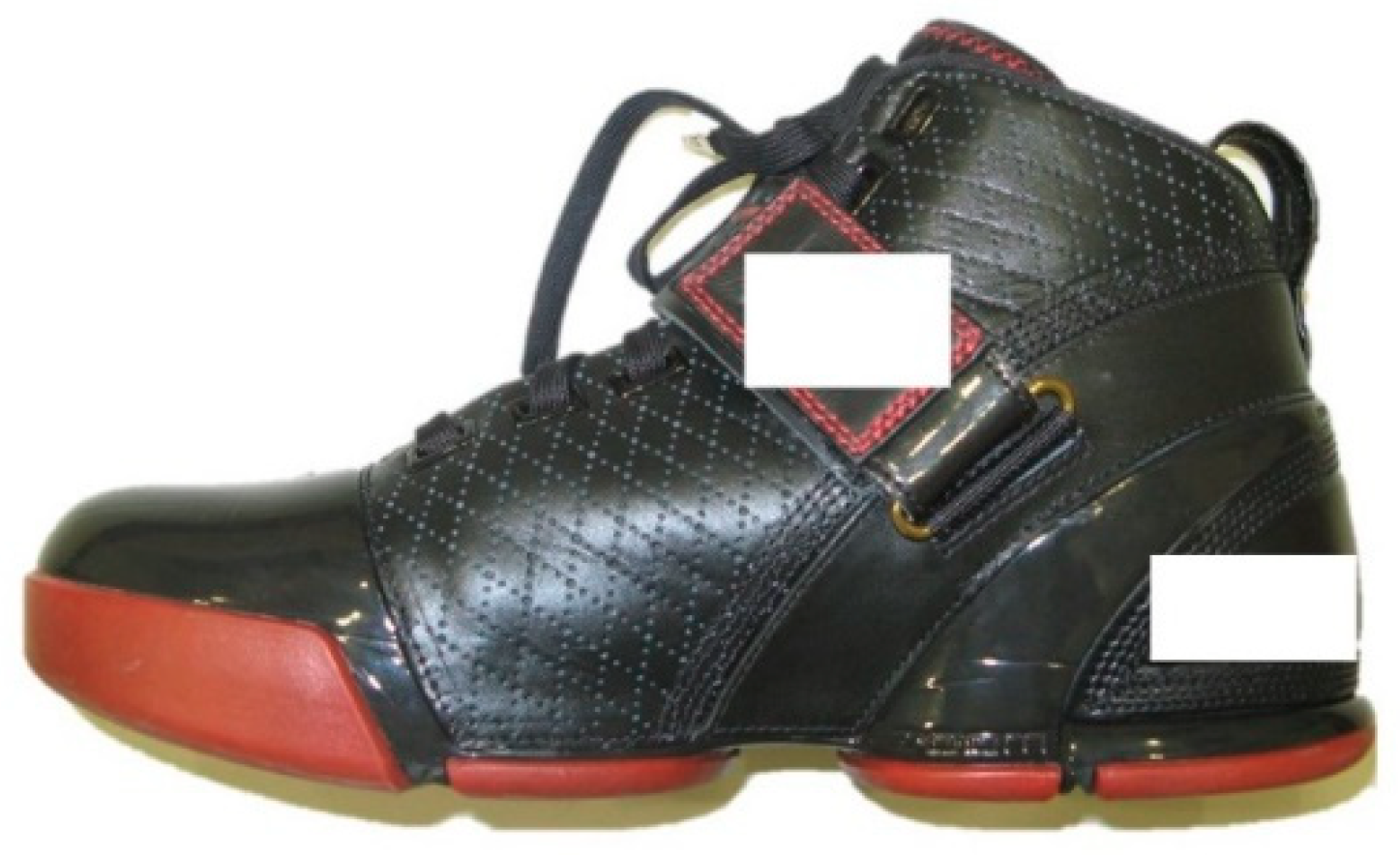
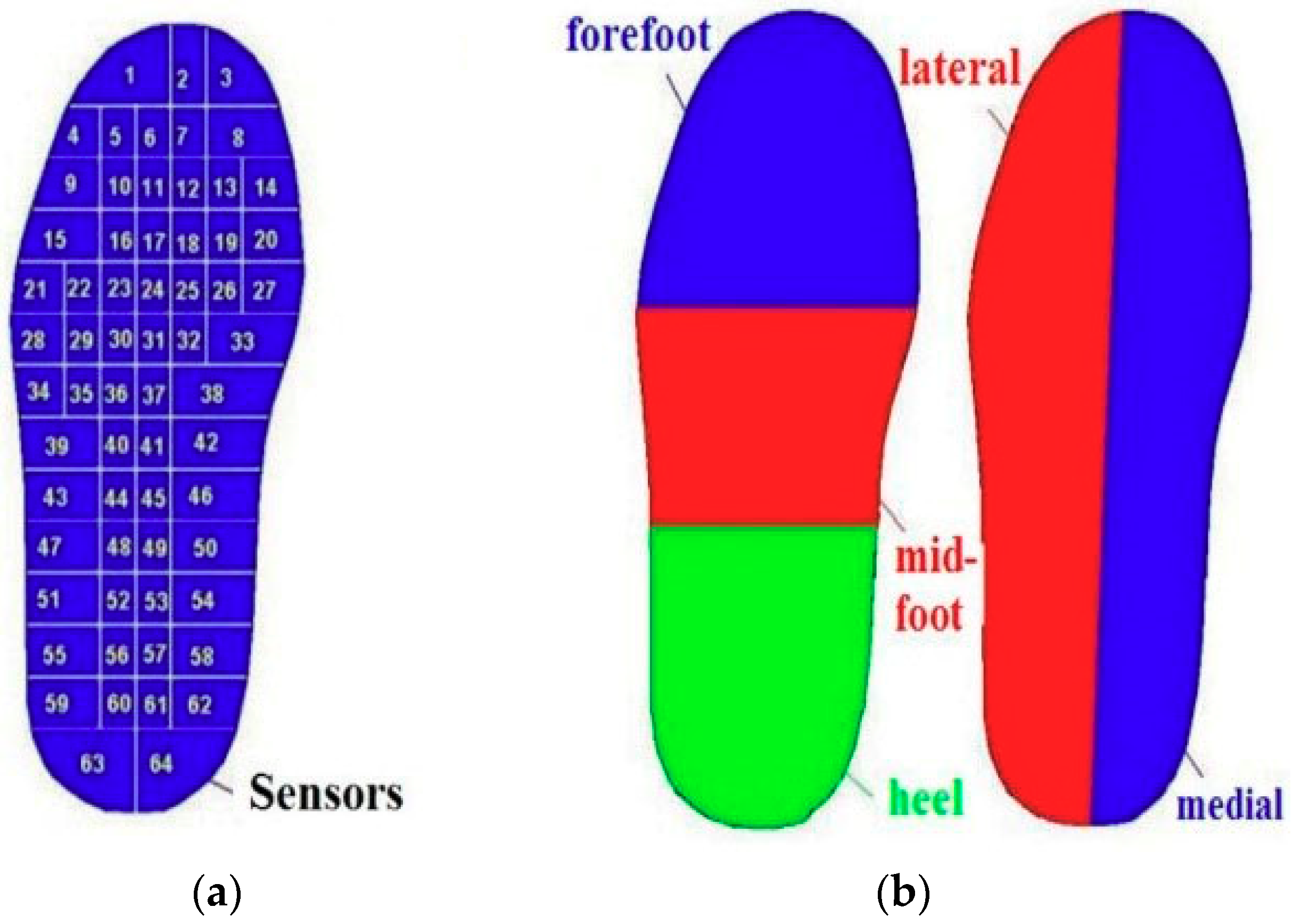
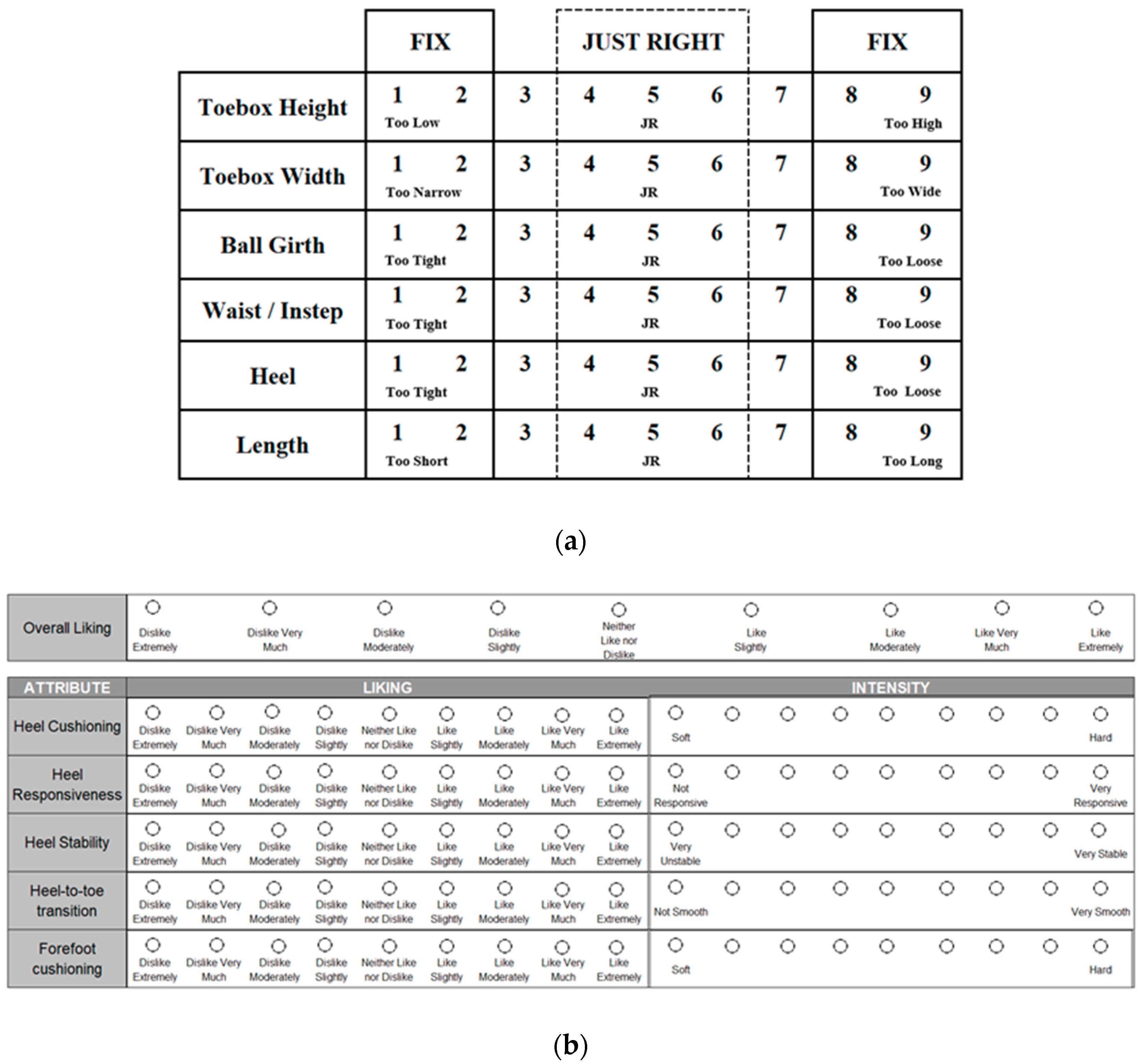
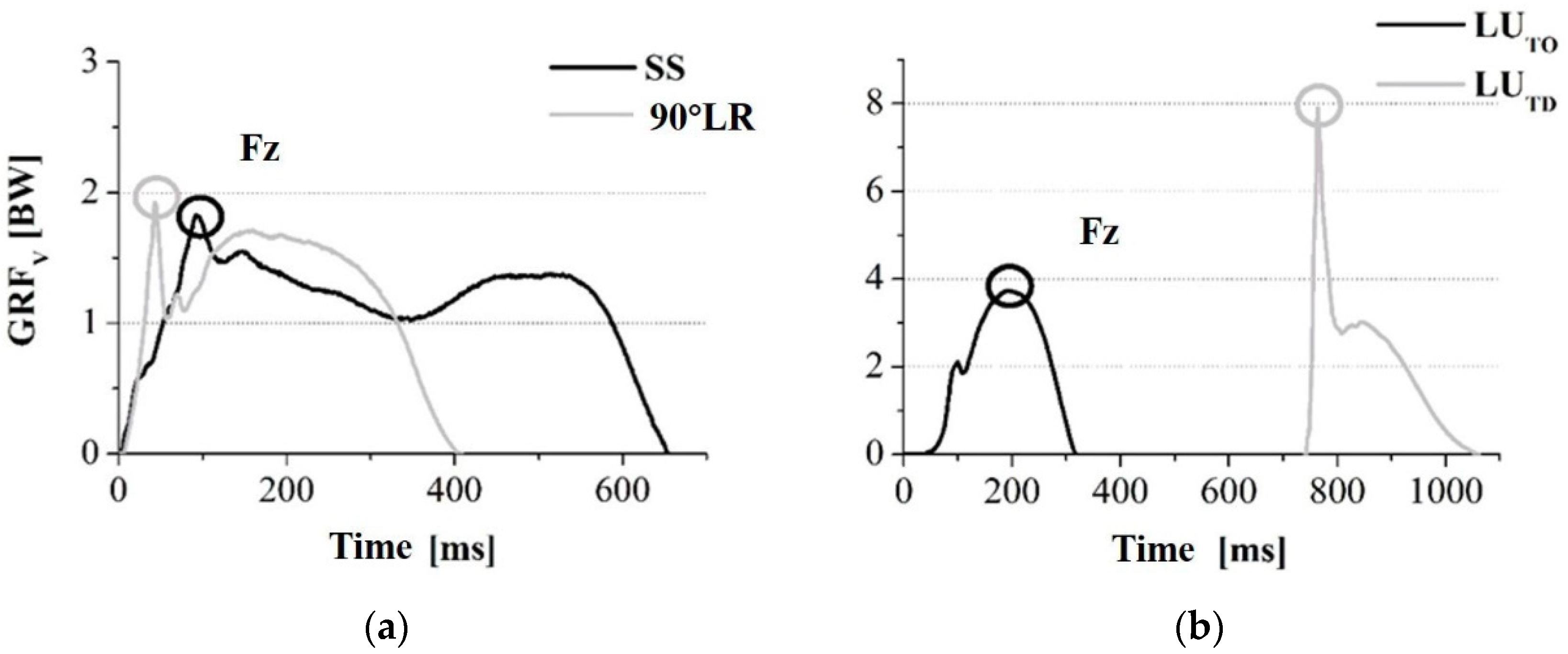
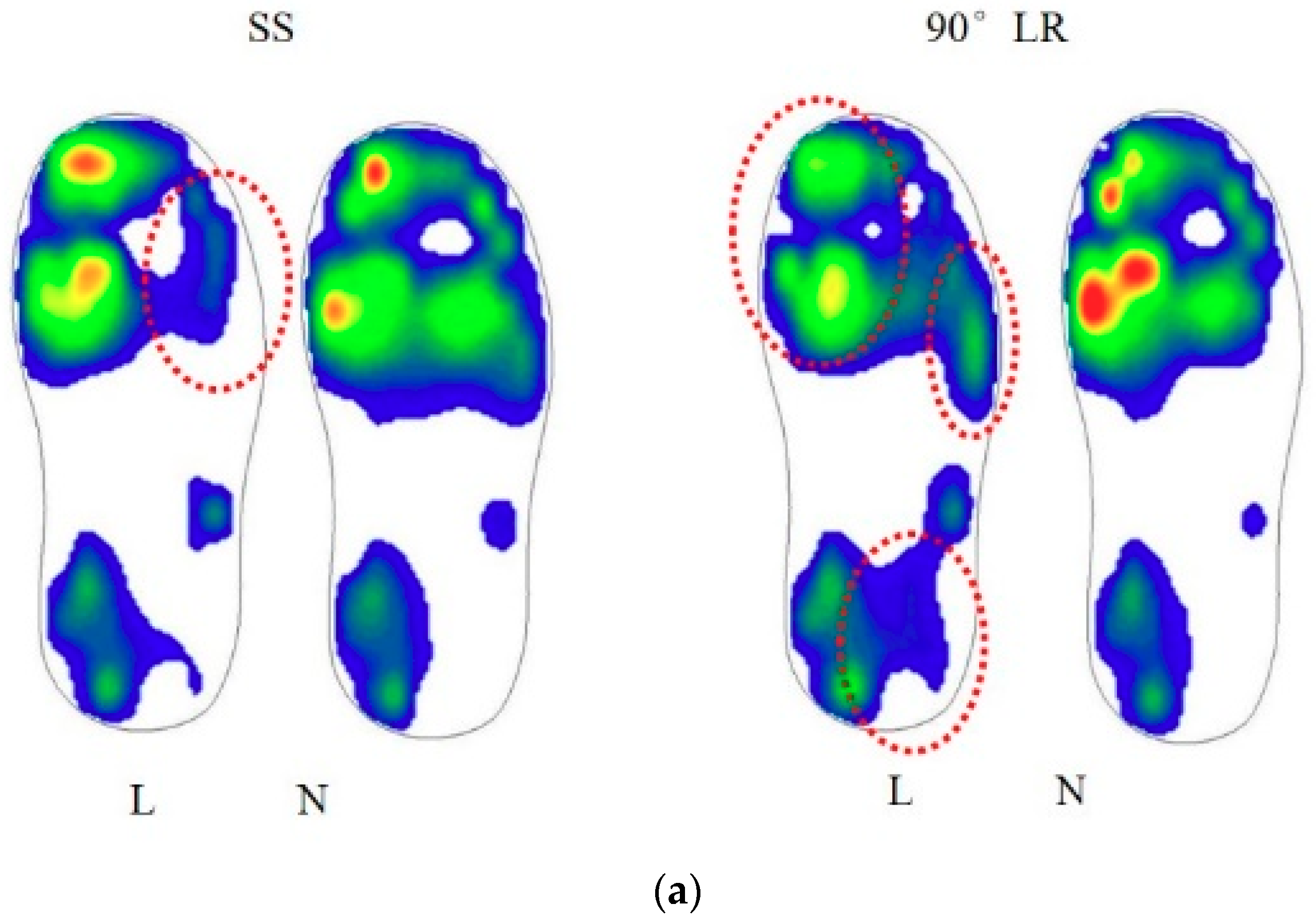
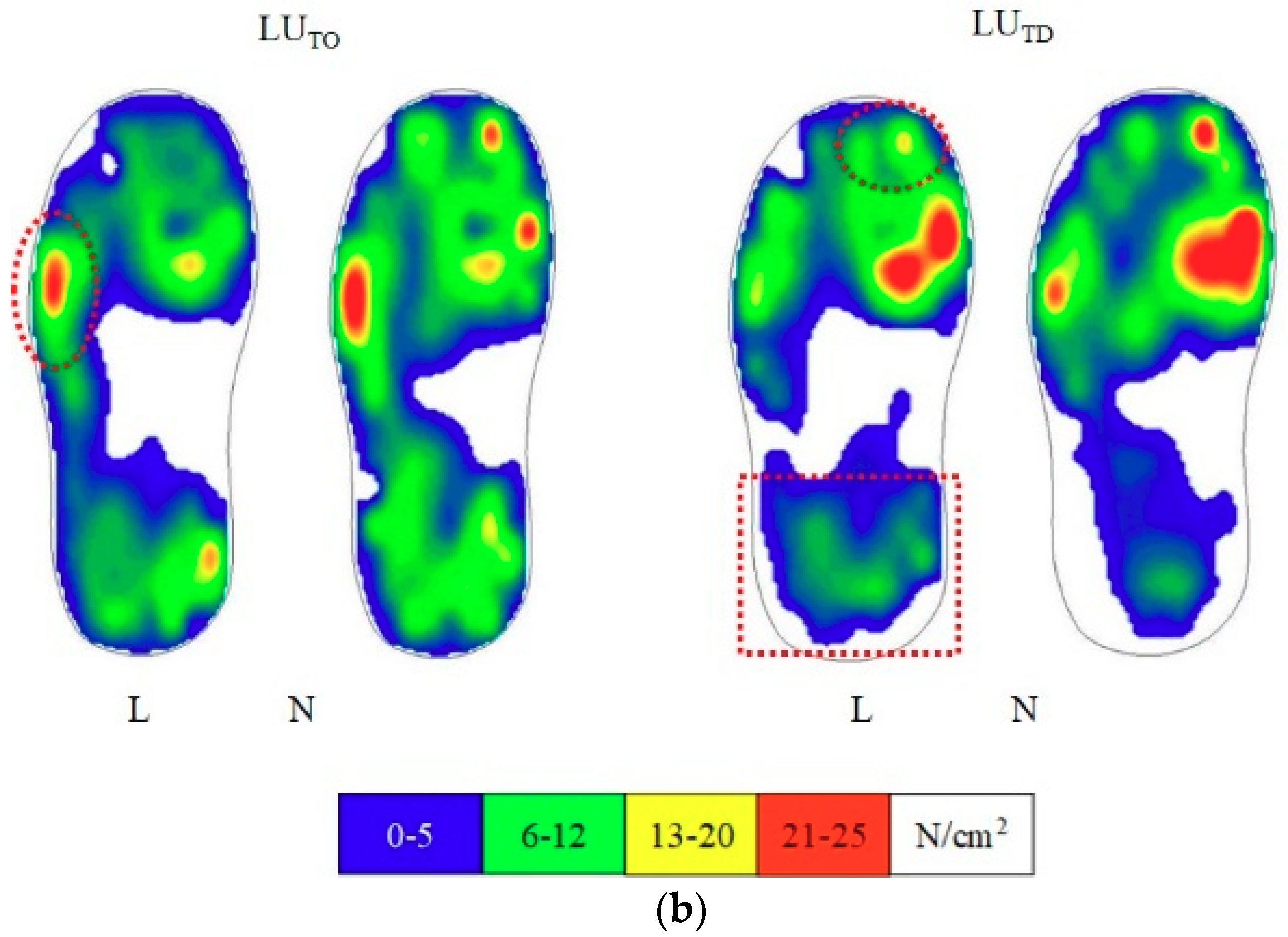
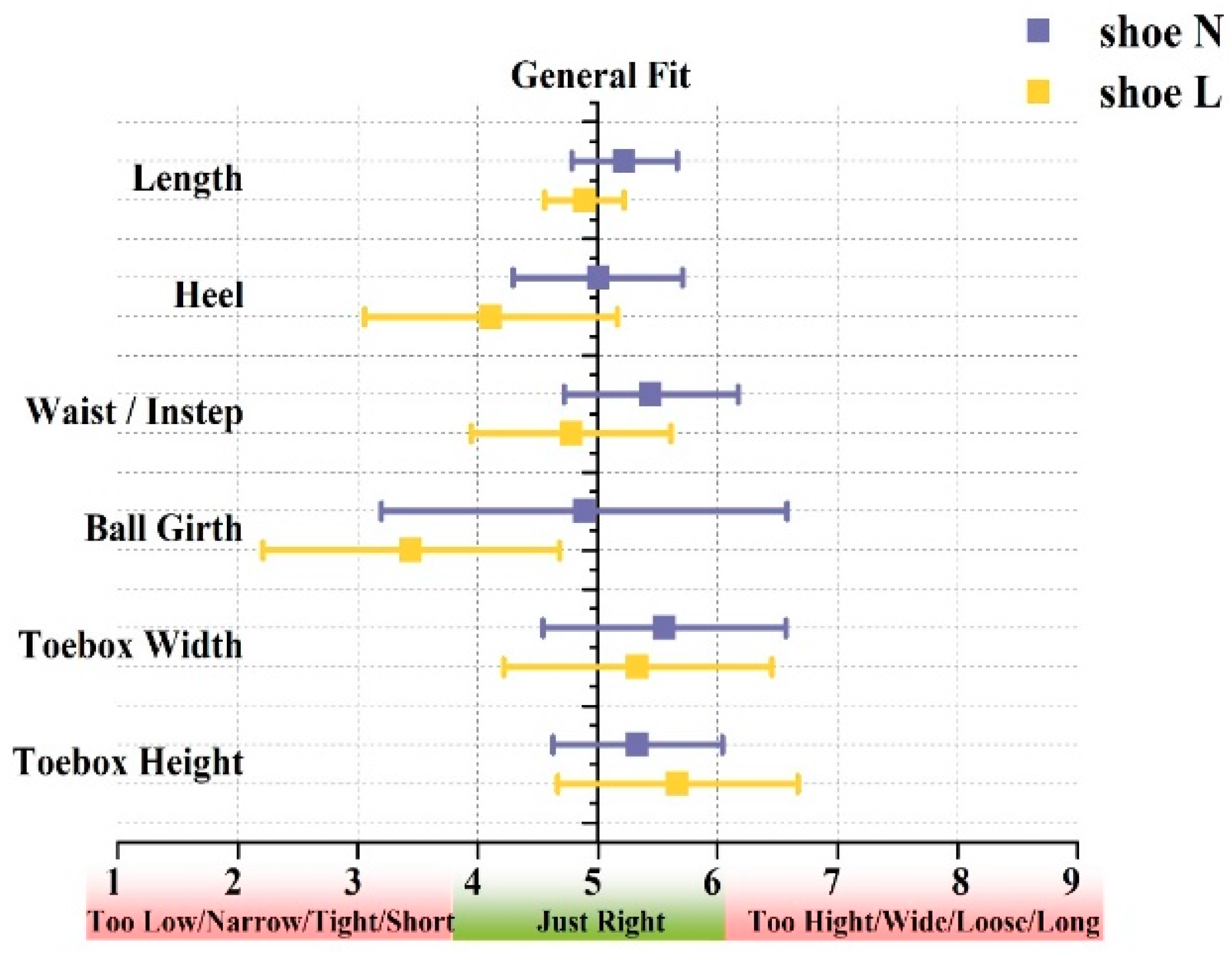
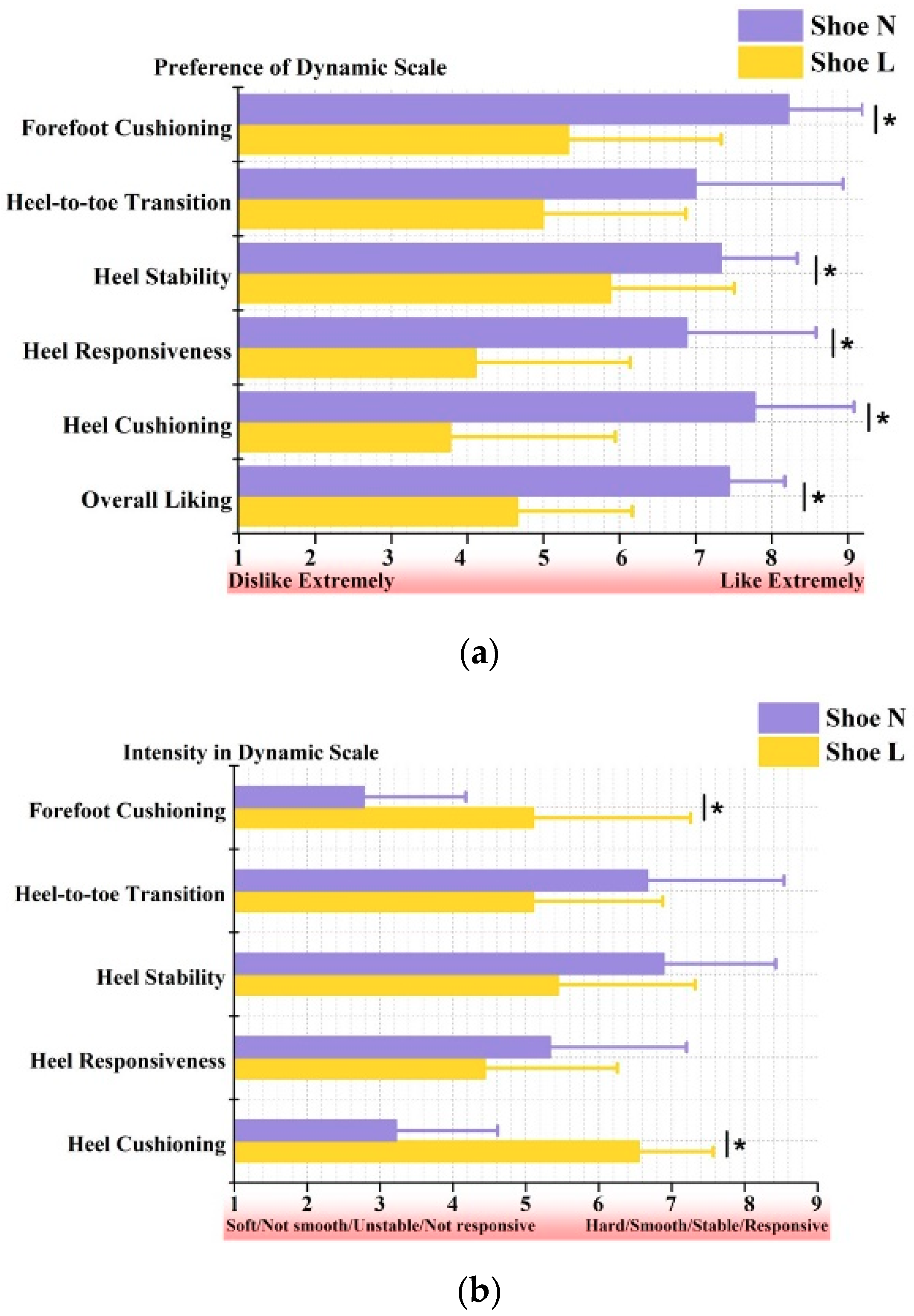
| Maneuvers | Shoes | Fz (BW) | tF (ms) | Gz (BW/ms) | tG (ms) |
|---|---|---|---|---|---|
| SS | L | 1.92 ± 0.32 | 74.4 ± 30.2 | 0.26 ± 0.18 | 27.2 ± 21.8 |
| N | 2.02 ± 0.43 | 63.3 ± 28.1 | 0.17 ± 0.06 | 19.7 ± 11.4 | |
| 90° LR | L | 2.47 ± 0.61 | 55.4 ± 25.6 | 0.35 ± 0.08 | 13.4 ± 12.6 |
| N | 2.25 ± 0.71 | 54.8 ± 26.4 | 0.21 ± 0.07 | 13.2 ± 9.7 | |
| LUTO | L | 3.53 ± 0.43 | 130.7 ± 47.6 | ||
| N | 3.55 ± 0.67 | 124.8 ± 42.1 | |||
| LUTD | L | 6.33 ± 3.10 | 26.4 ± 9.7 | 1.13 ± 0.87 | 10.3 ± 4.2 |
| N | 9.72 ± 3.42 | 28.6 ± 13.8 | 0.93 ± 0.32 | 11.9 ± 4.8 | |
| Maneuvers | Shoe | Maximum Pressure of Each Plantar Region (N/kg/cm2) | |||||
|---|---|---|---|---|---|---|---|
| Entire | Forefoot | Midfoot | Heel | Lateral | Medial | ||
| SS | L | 0.028 ± 0.008 * | 0.037 ± 0.018 | 0.011 ± 0.012 ** | 0.024 ± 0.014 | 0.026 ± 0.013 | 0.033 ± 0.005 |
| N | 0.032 ± 0.006 | 0.043 ± 0.022 | 0.023 ± 0.016 | 0.029 ± 0.014 | 0.031 ± 0.015 | 0.035 ± 0.008 | |
| 90° -LR | L | 0.028 ± 0.018 | 0.048 ± 0.031 | 0.020 ± 0.015 | 0.026 ± 0.018 | 0.026 ± 0.018 | 0.033 ± 0.023 |
| N | 0.030 ± 0.019 | 0.051 ± 0.034 | 0.023 ± 0.021 | 0.025 ± 0.017 | 0.027 ± 0.019 | 0.035 ± 0.024 | |
| LUTO | L | 0.061 ± 0.008 | 0.098 ± 0.014 | 0.048 ± 0.009 ** | 0.080 ± 0.018 | 0.072 ± 0.009 | 0.054 ± 0.010 |
| N | 0.063 ± 0.012 | 0.093 ± 0.018 | 0.061 ± 0.014 | 0.082 ± 0.020 | 0.075 ± 0.014 | 0.053 ± 0.012 | |
| LUTD | L | 0.064 ± 0.011 | 0.081 ± 0.019 | 0.050 ± 0.017 ** | 0.093 ± 0.038 | 0.063 ± 0.011 ** | 0.067 ± 0.019 |
| N | 0.071 ± 0.012 | 0.082 ± 0.022 | 0.064 ± 0.017 | 0.099 ± 0.038 | 0.070 ± 0.011 | 0.076 ± 0.023 | |
© 2019 by the authors. Licensee MDPI, Basel, Switzerland. This article is an open access article distributed under the terms and conditions of the Creative Commons Attribution (CC BY) license (http://creativecommons.org/licenses/by/4.0/).
Share and Cite
Zhang, X.; Luo, Z.; Wang, X.; Yang, Y.; Niu, J.; Fu, W. Shoe Cushioning Effects on Foot Loading and Comfort Perception during Typical Basketball Maneuvers. Appl. Sci. 2019, 9, 3893. https://doi.org/10.3390/app9183893
Zhang X, Luo Z, Wang X, Yang Y, Niu J, Fu W. Shoe Cushioning Effects on Foot Loading and Comfort Perception during Typical Basketball Maneuvers. Applied Sciences. 2019; 9(18):3893. https://doi.org/10.3390/app9183893
Chicago/Turabian StyleZhang, Xini, Zhen Luo, Xi Wang, Yang Yang, Jiaxin Niu, and Weijie Fu. 2019. "Shoe Cushioning Effects on Foot Loading and Comfort Perception during Typical Basketball Maneuvers" Applied Sciences 9, no. 18: 3893. https://doi.org/10.3390/app9183893




